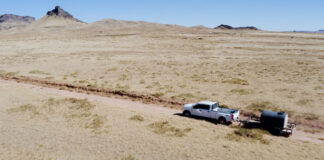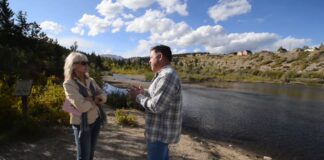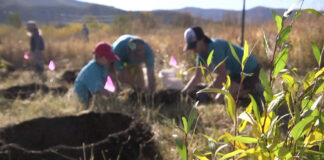By Sara Cottle, Laura Daley, Alex Feltes and Julia Medeiros
Water challenges are prompting scientists in Colorado to look for solutions from a once-prominent native animal that was almost hunted to the brink of extinction: the beaver.
Beavers were formerly a common sight in Colorado, but the 19th century fur trade caused their population to plummet, and they never really recovered.
“Traditionally, beavers would have been pervasive. Beaver dams would have been across the landscape, up the mountains and down into the plains,” said Mac Kobza, Boulder County wildlife biologist.
Beavers were once a common sight in Colorado but the 19th century fur trade caused their population to plummet, and they never really recovered.
Trial program reintroducing beavers in Boulder County
Kobza and fellow wildlife biologist Dave Hoerath are part of an effort to try out beaver reintroduction in Boulder County. They recently relocated beavers to Caribou Ranch, a once thriving beaver pond that has dried up since the furry, dam engineering residents left a decade ago.
Caribou Ranch was identified as ideal habitat by using a remote sensing technology called the Beaver Restoration Assessment Tool (BRAT).
“It looks at vegetation that is available, it looks at the structure of a valley and of a river, how much water is there, how steep is it, things that beavers would care about when it comes to building their dams,” said Juli Scamardo, a doctoral student in fluvial geomorphology at Colorado State University.
Mitigating the impact of furry movers and shakers on neighboring communities
Scamardo is studying how watersheds change in response to beaver reintroduction. She and her advisor, Ellen Wohl, utilized BRAT to examine areas across the St. Vrain drainage basin. In addition to looking for suitable physical characteristics for beaver dams, they also needed to factor in nearby human activity. As helpful as beavers can be for the environment, they can also pose a threat to human property by felling trees or flooding backyards.
As helpful as beavers can be for the environment, they can also pose a threat to human property by felling trees or flooding backyards.
Caribou Ranch fit the bill: a place where beavers could provide benefits for water storage and water quality without human interference. Researchers hope reintroducing beavers will improve the parched landscape not only in Caribou Ranch, but also potentially across the state.
“The ultimate goal of beaver reintroduction in Colorado is kind of getting back to what these valley bottoms or rivers used to look like before people came in,” said Scamardo. “But we’re never going to get exactly back to what it looked like before humans because we are now part of the landscape too.”
Watch the video
The Water Desk is pleased to present this short documentary about beaver reintroduction efforts in Colorado, produced for The Water Desk by University of Colorado Boulder graduate students Sara Cottle, Laura Daley, Alex Feltes and Julia Medeiros.






